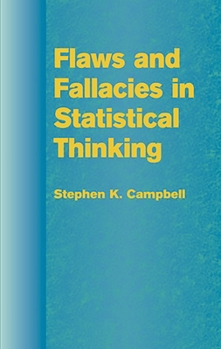Flaws and Fallacies in Statistical Thinking
Select Format
Select Condition 
Book Overview
Nontechnical survey helps to improve the ability to judge the quality of statistical evidence and to make better-informed decisions. Discusses common statistical pitfalls: unrealistic estimates,... This description may be from another edition of this product.
Format:Paperback
Language:English
ISBN:0486435989
ISBN13:9780486435985
Release Date:March 2004
Publisher:Dover Publications
Length:200 Pages
Weight:0.55 lbs.
Dimensions:0.5" x 5.5" x 8.5"
Customer Reviews
4 ratings
Interesting, amusing, and educational
Published by Thriftbooks.com User , 16 years ago
"Flaws and Fallacies in Statistical Thinking" by Stephen K. Campbell is interesting, amusing, and educational. The author examines less-than-honest claims and faults in statistical thinking. While the average person may have some difficulty in following the material, the author is clear and the material is worth the effort. The book will be of most help to those of us who must deal with statistics on an everyday basis and is a must read to anyone who does any sort of science work. If you are going to read a book like Al Gore's book on Global Warming, this book is required reading before Gore's book. Why? Well, if you are armed with some of the knowledge presented herein, you will have a very different view of Gore's book than a naive person would. I recommend this book to anyone who uses their brains.
A Guiding Light through Statistical Smoke Screens
Published by Thriftbooks.com User , 17 years ago
Over the past few years, several popular books have been written to inform the reader on misuses and abuses of statistical information. Since this is a 2002 reprint of a book published in 1974, it may very well be one of the first of its type. Despite this, the fact that it is still in print is testimony to this book's continuing usefulness and reader-friendliness. Indeed, the information that it contains is presented is a clear and engaging fashion. The author, an expert in the field, writes in an authoritative yet very friendly style. The book, being non technical, does not contain any equations to speak of in the main text, although some are included in footnotes for those who are mathematically inclined. The examples that are used may be dated but they are quite effective in illustrating the points being made. This book can be enjoyed by anyone, especially those who are fascinated by (or want to be aware of) the methods that are used to distort statistical information to serve some ulterior purpose.
A new edition needed, published in the 1970s
Published by Thriftbooks.com User , 19 years ago
Published in 1974, this book could benefit from an up-to-date revision to accommodate some changes over the last 30 years. Nonetheless, the book is still useful as it is, for students of statistics, or, indeed, for anyone who reads newspapers and magazines and comes across statistics there. The book is not too much more interesting than a textbook, but the author does attempt to make it seem so, adding cartoons and writing in a "chatty" style. He helps readers by categorizing various statistical flaws and fallacies into one of several areas. He also provides relatively simple explanations of correlation and regression analysis, topics usually difficult to comprehend. One aspect that Campbell, the author, seems to overlook, or deem not worth commenting on, is that most of his examples are drawn from the public media. What goes unwritten and unsaid is that the media seem to have a vested interest in distorting statistics, for the simple reason that they want to impress readers with clearly unusual, clearly frightening, or other clear differences between what they expected and what was found. The media are out to report news, but they are certainly not averse to "making" news, if it can be done through a fallacious reporting of statistics. Campbell never mentions this, but it is clear to see, reading his examples. Anyone who has taken college-level courses in scientific methodology or statistics will already be familiar with many of Campbell's most egregious errors: such as drawing conclusions about an entire population from a small and/or non-random sample; or such as concluding that one variable causes another variable, because they correlate highly. For these students, the book provides an excellent review. Diximus.
Yeah, Baby! Shagadelic!
Published by Thriftbooks.com User , 21 years ago
Campbell's discussion of common flaws and fallacies in statistical reasoning is clear and useful, but those cringe-inducing "sexy" cartoons from those swinging, wife-swapping, care-free early 1970s are manna from camp heaven! Every other page features would-be witty drawings of hip, bearded, wide-tie-wearing swinger dudes ogling mini-skirted chicks and making sexist remarks--all of which bear scant relation to the topics being discussed. Example: In a chapter on rates of rise and fall we see Hepcat Swinger Dude leering at backside of chick's tiny miniskirt as he wishes aloud that trends will continue to rise. (How very droll, Noel!) Yeah, that'll go over well in today's colleges. No wonder it's out of print and has been replaced with a heavily revised and re-titled version for today's market. If you have a taste for politically incorrect 70s kitsch and want to learn some useful stuff about statistical fallacies, get this book now!






